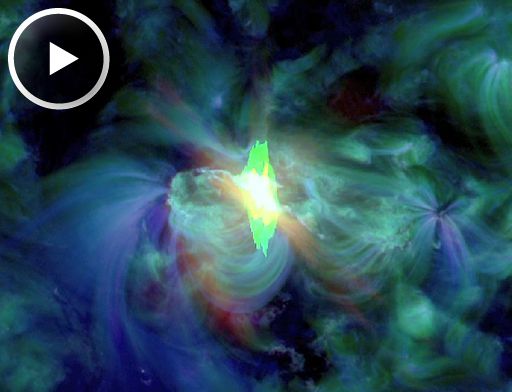MORNING CONJUNCTION: Mars, the 1st-magnitude star Regulus, and Comet ISON have gathered together in the pre-dawn sky only a few degrees apart. Comet ISON is invisible to the naked eye, but Mars and Regulus are bright enough to see without optics. They form a pretty red-blue "double star" that can lead telescopic observers to the comet. Sky maps: Oct. 13, 14, 15.
M-CLASS FLARE, EARTH-DIRECTED CME: October 13th began with an explosion on the sun. At 00:43 UT, sunspot AR1865 erupted, producing an M1-class solar flare and an Earth-directed CME. NASA's Solar Dynamics Observatory captured the explosion's flash of extreme UV radiation:
Soon after the flare, the Solar and Heliospheric Observatory recorded a faint CME emerging from the blast site. Based on the approximate speed of the expanding cloud, between 600 km/s and 800 km/s, it will probably reach Earth on Oct. 15-16. Polar geomagnetic storms are possible when the CME arrives. Aurora alerts: text, voice

Solar wind
speed: 327.8 km/sec
density: 1.1 protons/cm3
explanation | more data
Updated: Today at 1847 UT
X-ray Solar Flares
6-hr max: C4 1758 UT Oct13
24-hr: M1 0043 UT Oct13
explanation | more data
Updated: Today at: 1800 UT
![]()
Daily Sun: 13 Oct 13
Sunspot AR1865 has a 'beta-gamma-delta' magnetic field that harbors energy for X-class solar flares. Credit: SDO/HMI
![]()
Sunspot number: 106
What is the sunspot number?
Updated 13 Oct 2013
Spotless Days
Current Stretch: 0 days
2013 total: 0 days (0%)
2012 total: 0 days (0%)
2011 total: 2 days (<1%)
2010 total: 51 days (14%)
2009 total: 260 days (71%)
Since 2004: 821 days
Typical Solar Min: 486 days
Update 13 Oct 2013
The Radio Sun
10.7 cm flux: 128 sfu
explanation | more data
Updated 13 Oct 2013
![]()
Current Auroral Oval:
Switch to: Europe, USA, New Zealand, Antarctica
Credit: NOAA/POES
![]()
Planetary K-index
Now: Kp= 1 quiet
24-hr max: Kp= 2 quiet
explanation | more data
Interplanetary Mag. Field
Btotal: 2.8 nT
Bz: 1 nT south
explanation | more data
Updated: Today at 1847 UT
![]()
Coronal Holes: 13 Oct 13
Solar wind flowing from this coronal hole should reach Earth on Oct. 15-16. Credit: SDO/AIA. ![]()





